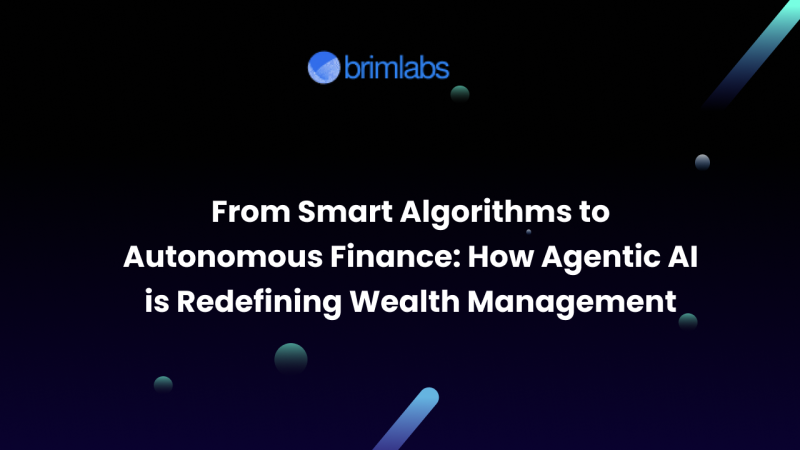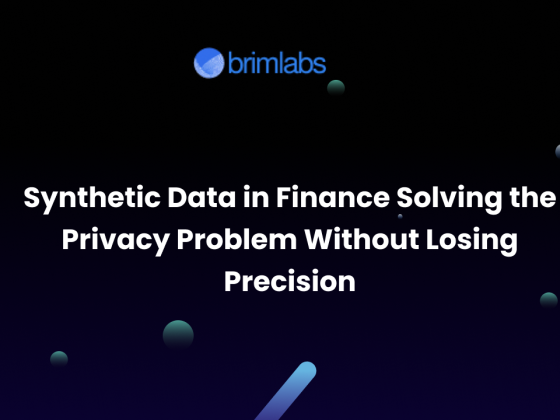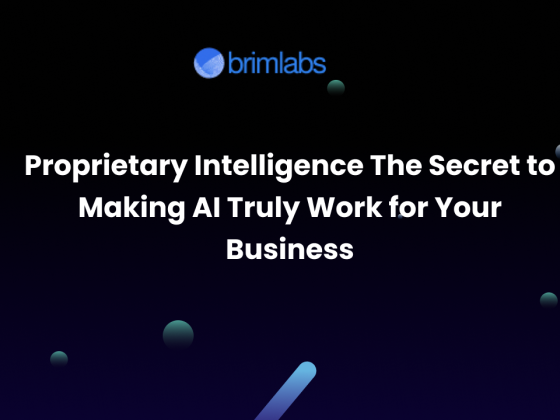For decades, wealth management has revolved around human expertise supported by analytical tools. Advisors combined intuition with spreadsheets, risk models, and client insights to craft personalized financial strategies. Then came machine learning, automating parts of the process with predictive analytics and robo-advisors. Today, a new era is emerging where financial systems no longer just assist, they act. The rise of agentic AI is transforming wealth management from smart automation to self-evolving intelligence that perceives, reasons, and decides.
The Shift from Algorithmic to Agentic
Smart algorithms were reactive. They processed structured data and executed predefined rules – efficient, but static. Agentic AI represents a dynamic evolution. It blends perception, reasoning, and autonomy, making financial systems capable of continuous learning and adaptation.
In traditional algorithmic systems, the logic was linear. For example, a portfolio rebalancing model might shift assets based on market thresholds or risk ratios. Agentic systems, however, operate in loops of observation, hypothesis, and action. They analyze news, monitor sentiment, simulate scenarios, and autonomously execute trades aligned with user-defined goals, adapting to changing contexts without explicit reprogramming.
This transition mirrors a broader evolution in AI. Instead of responding to triggers, agents act as autonomous decision-makers within digital ecosystems. They interact with other agents, APIs, and human stakeholders, forming a collaborative network of intelligence across the financial landscape.
From Data Models to Cognitive Portfolios
Wealth management has always been about understanding risk and opportunity. But the explosion of real-time data, from market movements and global events to behavioral and ESG signals has made manual interpretation nearly impossible. Agentic AI steps into this complexity by creating cognitive portfolios that think in context.
These portfolios go beyond asset allocation. They dynamically assess:
- Macroeconomic shifts to reweight positions in anticipation of interest rate changes
- Behavioral trends from news, social media, or retail sentiment
- Regulatory and ESG impacts on investment decisions
- Client-specific intent and psychology to personalize recommendations
Such systems treat every portfolio as a living organism. They continuously sense and respond to the environment, ensuring decisions are timely, compliant, and contextually relevant.
Autonomous Financial Agents in Action
Agentic AI introduces the concept of autonomous financial agents, self-directed entities capable of performing complex tasks across the financial lifecycle. These agents do not replace human advisors but augment their capabilities by operating at machine speed and scale.
Some real-world examples include:
- Investment bots that analyze millions of market variables and rebalance assets based on probabilistic reasoning rather than static rules
- Risk-assessment agents that integrate with credit systems to predict liquidity threats and pre-empt financial exposure
- Compliance agents that monitor transactions for regulatory breaches, automating Know Your Customer (KYC) and Anti-Money Laundering (AML) checks
- Advisory companions that interpret client goals through conversational interfaces and align portfolios dynamically with their evolving life events
This convergence of autonomy and intelligence allows financial ecosystems to function like self-governing, adaptive, and resilient.
Reinventing the Role of Financial Advisors
The arrival of agentic AI does not eliminate advisors; it elevates them. Instead of spending hours on manual research and reporting, wealth managers can now focus on strategic decision-making and client relationships.
Agentic systems handle the execution and analysis layer, while human advisors manage interpretation and trust. Together, they form a hybrid intelligence model where human judgment and machine precision coexist. This combination is especially vital in emotionally charged decisions such as inheritance planning, ESG investments, or long-term wealth transfers.
In effect, advisors evolve into orchestrators of AI agents, configuring objectives, interpreting insights, and ensuring outcomes align with client values. The future wealth manager will not be defined by their ability to read charts but by their fluency in designing and supervising autonomous financial ecosystems.
Building Trust in Autonomous Finance
Trust remains the cornerstone of finance. As AI takes on more autonomous roles, transparency and explainability become non-negotiable. Agentic systems must justify their decisions in human-understandable ways, especially when managing millions in client assets.
New governance models are emerging to ensure that autonomy never crosses accountability. Explainable AI (XAI) techniques help trace decision pathways, while zero-knowledge proofs and blockchain-based audit trails verify compliance without revealing sensitive data. Ethical frameworks ensure that AI agents remain aligned with fiduciary duties and regulatory standards.
The industry is also seeing the rise of AI custodians, meta agents that monitor other agents to enforce boundaries, detect anomalies, and flag deviations. This layered oversight prevents rogue automation and ensures that autonomy remains grounded in responsibility.
The Economic Edge of Agentic Wealth Systems
Beyond intelligence, agentic AI delivers measurable economic impact. Wealth management firms adopting autonomous systems report significant gains:
- Faster execution cycles, reducing decision latency from hours to milliseconds
- Higher portfolio resilience, driven by continuous monitoring and risk mitigation
- Personalized product offerings, dynamically tailored to micro-segments
- Cost efficiency, with operating margins improved by up to 30 percent through automation
In competitive markets where customer expectations evolve daily, agentic architectures offer the agility to stay ahead. They turn data into foresight, risk into opportunity, and complexity into clarity.
The Architecture of Autonomous Finance
At a technical level, agentic finance relies on multi-agent orchestration rather than centralized control. Each agent performs a specific function – data gathering, analysis, decisioning, execution, while communicating through shared protocols and secure APIs.
A typical architecture includes:
- Perception layer that continuously aggregates structured and unstructured data from exchanges, news, and user inputs
- Cognitive layer powered by domain-specific large language models fine-tuned for finance and compliance
- Decision layer where reinforcement learning and probabilistic reasoning guide portfolio actions
- Execution layer integrating with broker APIs, payment gateways, and compliance systems
- Governance layer ensuring traceability, security, and ethical oversight
Together, these layers form a self-correcting ecosystem capable of adaptive learning and outcome optimization.
The Road Ahead: From Autonomous Agents to Collective Intelligence
The next frontier is not a single autonomous advisor but a network of agents collaborating across institutions. Imagine a world where personal finance agents negotiate with market agents, lending agents, and insurance agents in real time to optimize wealth for both individuals and ecosystems.
Such a model moves finance from competition to collaboration, where intelligence is distributed yet coordinated. It mirrors the shift from static databases to living knowledge graphs, continuously updated, self-healing, and interconnected.
This evolution will blur traditional boundaries between banks, advisors, and fintech startups. The winners will be those who can design interoperable agent ecosystems that learn faster, act responsibly, and deliver consistent value.
Challenges and Ethical Imperatives
Despite its promise, agentic finance brings new challenges. Biases in training data can create uneven outcomes. Autonomy without oversight risks unintended financial exposure. Security vulnerabilities could open new attack surfaces. Regulators will need to rethink frameworks to govern AI-led decision-making while preserving innovation.
The financial industry must adopt principles of algorithmic transparency, fairness, and human-in-the-loop validation. Ethical AI is not a checkbox, it is a continuous commitment to accountability and inclusivity. As wealth systems gain autonomy, the measure of progress will not be just performance but trustworthiness.
Conclusion
The era of agentic AI marks a profound transformation in how wealth is created, managed, and grown. From passive automation to proactive intelligence, finance is entering a phase where systems do not just follow instructions, they understand intent and pursue goals.
Agentic wealth platforms will democratize access, empower advisors, and unlock hyper-personalized financial experiences. The future will not belong to those with the best algorithms, but to those who can orchestrate intelligent agents aligned with human values.
At Brim Labs, we help financial institutions and wealth-tech innovators build this new foundation of autonomous finance. Through advanced AI architectures, secure multi-agent systems, and outcome-driven engineering, Brim Labs is redefining what financial intelligence can achieve in the age of agency.
Bokep Indonesia Bokep Jepang Jav Bokep jilbab Bokep Indonesia Terbaru Bokep Indonesia Viral BOKEP VIRAL Bokep Jepang Jav BOKEP INDONESIA BOKEP INDO SLOT GACOR SLOT GACOR










